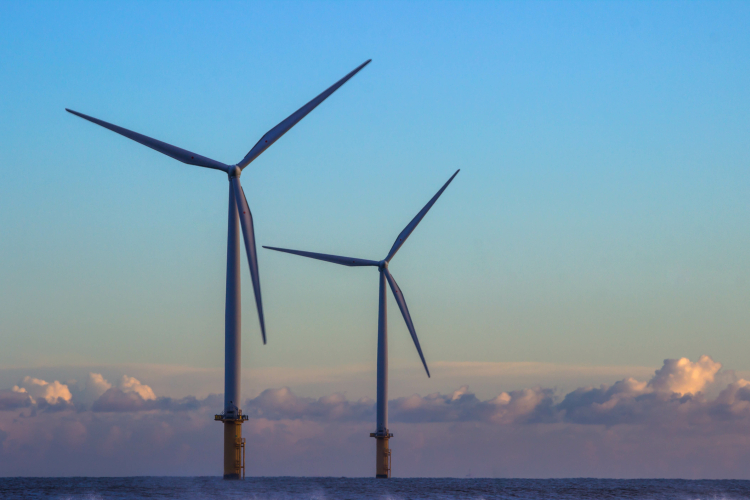
In offshore wind, Massachusetts has a vast renewable energy resource right off its coasts. While recent federal actions have slowed project timelines in the United States, offshore wind is a commercially mature technology, with more than 70 gigawatts (GW) deployed globally.
The Commonwealth remains committed to growing this industry and capturing its economic and environmental benefits, many of which are already being realized.
Offshore Wind is Already Delivering for Massachusetts
The advantages of offshore wind are not just future promises; they are happening now. Massachusetts has seen significant investments in project development, port facilities, transmission systems, supply chain businesses, vessels, and training infrastructure that have put hundreds of people to work and are preparing many more workers for future careers in this field.
The New Bedford Marine Commerce Terminal, the first port facility in the nation specifically designed for offshore wind, is an active staging hub for one of the first commercial scale projects, Vineyard Wind 1. The terminal is not only hosting dozens and dozens of skilled workers and subcontractors across a wide range of trades every day but also boosting the South Coast economy by expanding local demand for goods and services provided by marine suppliers, restaurants, lodging, and many other local businesses.
Additionally, communities are gaining new infrastructure, upgraded waterfronts, and supply chain jobs connected to this growth.
With support from MassCEC, industry, trades, educators, and community-based organizations are developing and delivering programs and hands-on training that connect jobseekers to steady, well-paying occupations. Safety certifications—covering sea survival, working at heights, and emergency response—are foundational for offshore wind professions but also apply across other maritime and energy industries. Combined with technical training in welding, electrical work, and project management, these programs ensure Massachusetts is building a workforce that will serve the clean energy economy for decades.
Offshore Wind Helps Keep Energy Prices Stable
Massachusetts households and businesses know the impact of winter energy price spikes, often driven by reliance on fossil fuels and aging infrastructure. When cold weather drives up demand, New England must compete in the global market for liquefied natural gas (LNG) shipped from overseas. With pipelines already at capacity and international suppliers raising prices, energy costs climb, and those costs are passed on to consumers. Offshore wind can help reduce this risk by providing a steady, local source of clean electricity.
A recent regional analysis found that 3.5 GW of offshore wind could have offset last winter’s natural gas price surge, lowering electricity prices by 11% and saving ratepayers $400 million over only 3 months. Looking ahead, reaching 9 GW of offshore wind across Massachusetts, Connecticut, and Rhode Island by 2030 could mean an average annual savings of $630 million, with some years exceeding $1.3 billion. In addition, projects like Vineyard Wind 1 provide fixed, 20-year prices that offer long-term stability in the face of volatile unpredictable fossil fuel costs.
Offshore Wind Strengthens Energy Reliability
A reliable energy system depends on a diverse mix of resources, and offshore wind adds an important new piece. By working alongside solar, hydropower, onshore wind, and other sources, offshore wind expands the portfolio of energy available to Massachusetts.
One of its unique advantages is timing: offshore wind tends to produce the most electricity in the colder months, when demand for heating and electricity is highest. This seasonal pattern makes it a valuable complement to solar, which peaks in the summer. Additionally, with average capacity factors higher than onshore wind and solar PV projects especially during mornings and evenings, offshore wind can help meet load peak daily demands, providing further system level benefits.
Energy demands only continue to increase, and there are challenges with adding new capacity related to the siting and permitting of new bulk generation facilities. Because offshore wind farms provide economies of scale—meaning that offshore wind farms become more cost-efficient as they get larger—regional power generation capacity and energy mix can shift significantly with the addition of a single offshore wind farm.
Adding offshore wind also means more of our energy is generated close to home. This reduces exposure to external supply pressures and helps keep the grid balanced year-round. By diversifying the mix, Massachusetts gains greater resilience and security, steadier prices, and the ability to plan for long-term energy needs with confidence. Offshore wind is not a replacement for other resources; it’s a practical addition that strengthens the entire system and makes energy more affordable to all consumers.
Offshore Wind Powers Our Energy Transition and Healthy Communities
Massachusetts law requires major shifts in how we power our homes and businesses, and offshore wind is one of the most impactful tools available to keep our energy transition on track. A single large project can supply electricity for hundreds of thousands of homes while preventing more than a million metric tons of carbon pollution each year.
The benefits also extend beyond combating climate change. Cutting back on fossil fuel generation reduces air pollution that contributes to asthma, heart disease, and other health challenges, especially in communities that have historically faced higher health burdens from polluted air. Offshore wind is not just about powering the grid—it’s also about creating healthier, more equitable communities across the state.
Powering Massachusetts Today and Tomorrow
Offshore wind is more than a clean energy resource; it’s a long-term investment in Massachusetts’ future. It means affordable and reliable power for households and businesses, steady jobs for workers across the state, cleaner air for our communities, and greater resilience in the face of global energy uncertainty. By continuing to build this industry, we’re ensuring that offshore wind remains a cornerstone of our energy system and a driver of economic growth for decades to come. We won’t let Massachusetts get left behind.
Learn more about how MassCEC is helping to build and grow the offshore wind industry in Massachusetts.

